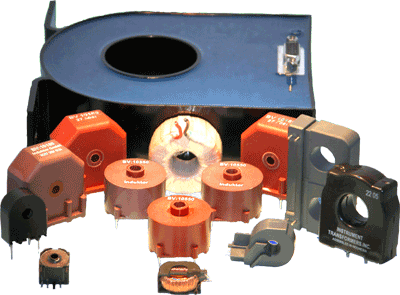Current Transformers
Desinged to provide a current in its secondary winding proportional to the alternating current flowing in its primary
Current Transformers
Generate a low, potential-free A.C output current in the proportion to the A.C. input current and corresponding to the low transformation current ratio.A current transformer (CT) is a type of instrument transformer designed to provide a current in its secondary winding proportional to the alternating current flowing in its primary. They are commonly used in metering and protective relaying in the electrical power industry where they facilitate the safe measurement of large currents, often in the presence of high voltages. The current transformer safely isolates measurement and control circuitry from the high voltages typically present on the circuit being measured.
Design
The most common design of CT consists of a length of wire wrapped many times around a silicon steel ring passed over the circuit being measured. The CT's primary circuit therefore consists of a single 'turn' of conductor, with a secondary of many hundreds of turns. The CT acts as a constant-current series device with an apparent power burden a fraction of that of the high voltage primary circuit. Hence the primary circuit is largely unaffected by the insertion of the CT. Common secondaries are 1 or 5 amperes. For example, a 4000:5 CT would provide an output current of 5 amperes when the primary was passing 4000 amperes. The secondary winding can be single ratio or multi ratio, with five taps being common for multi ratio Cts.
Usage
Current transformers are used extensively for measuring current and monitoring the operation of the power grid. The CT is typically described by its current ratio from primary to secondary. Often, multiple CTs are installed as a "stack" for various uses (for example, protection devices and revenue metering may use separate Cts). The multi ratio CTs are typically used for current matching in current differential protective relaying applications.Safety precautions
Care must be taken that the secondary of a current transformer is not disconnected from its load while current is flowing in the primary, as this will produce a dangerously high voltage across the open secondary, and may permanently affect the accuracy of the transformer.Accuracy
The accuracy of a CT is directly related to a number of factors including:• burden
• rating factor
• load
• external electromagnetic fields
• temperature
• physical configuration.
Burden
The burden in a CT metering circuit is essentially the amount of impedance (largely resistive) present. Typical burden ratings for CTs are B-0.1, B-0.2, B-0.5, B-1.0, B-2.0 and B-4.0. This means a CT with a burden rating of B-0.2 can tolerate up to 0.2 ? of impedance in the metering circuit before its output current is no longer a fixed ratio to the primary current. Items that contribute to the burden of a current measurement circuit are switch blocks meters and intermediate conductors. The most common source of excess burden in a current measurement circuit is the conductor between the meter and the CT. Often, substation meters are located significant distances from the meter cabinets and the excessive length of small gauge conductor creates a large resistance. This problem can be solved by using CT with 1 ampere secondaries which will produce less voltage drop between a CT and its metering devices.Rating factor
Rating factor is a factor by which the nominal fullload current of a CT can be multiplied to determine its absolute maximum measurable primary current. Conversely, the minimum primary current a CT can accurately measure is "light load," or 10% of the nominal current (there are, however, special CTs designed to measure accurately currents as small as 2% of the nominal current). The rating factor of a CT is largely dependent upon ambient temperature. Most CTs have rating factors for 35 degrees Celsiusand 55 degrees Celsius. It is important to be mindful of ambient temperatures and resultant rating factors when CTs are installed inside pad-mounted transformers or poorly ventilated mechanical rooms.Recently, manufacturers have been moving towards lower nominal primary currents with greater rating factors. This is made possible by the development of more efficient ferrites and their corresponding hysteresis curves. This is a distinct advantage over previous CTs because it increases their range of accuracy, since the CTs are most accurate between their rated current and rating factor.
